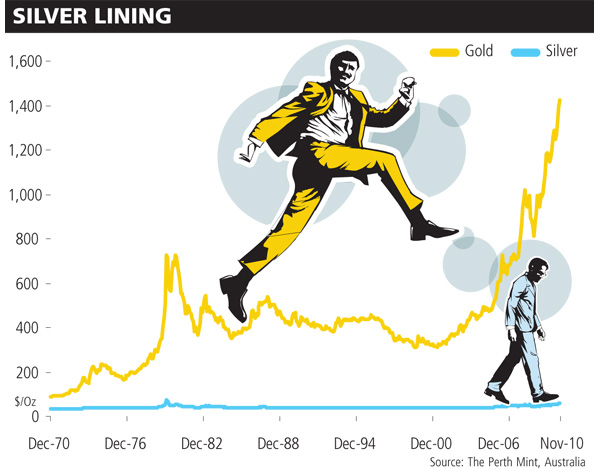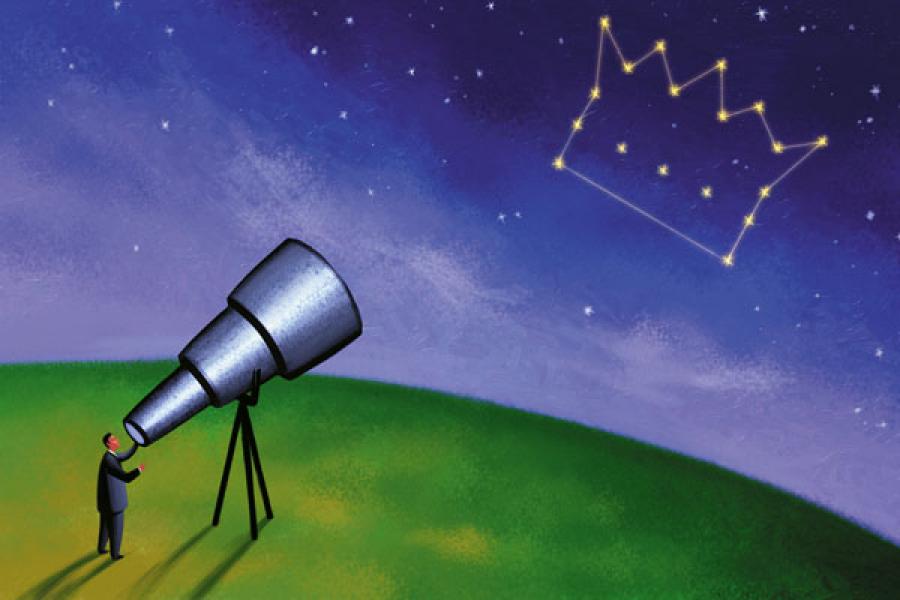
Bullion: The White Revolution
Gold has shown all the signs of scaling new peaks, but still silver may outperform the yellow metal in 2011
Gold is a foul-weather friend. In times of war, recession and political turmoil, it always goes up. Looking around us, we can see so many signs of instability right now. The threat of terrorism has increased all over, especially so in India. Western Europe is afflicted with a debt contagion. The Korean Peninsula is in the tinder box. All signs that the appeal of gold will remain strong in 2011.
Gold also likes abundant liquidity. It not only brings a lot of capital into the market for the yellow metal, but also stokes inflation across countries. That makes people put their money in gold as a safe haven. The money flood from the US is expected to be inflationary. Another sign that gold will continue to rise, never mind the five-year long boom it has already had.
In the market, everyone seems to be voting for gold with their wallets. JPMorgan Chase recently re-opened its gold vault in New York after 10 years as high net worth individuals sought vaults for their newly acquired stocks.
India, the largest repository of gold in the world, appeared as though it had lost its famed appetite for the metal for a while. But when the Reserve Bank of India bought 200 tonnes in November 2009, it encouraged the people to come back to the market and start buying again. In 2010, Indians put in more than Rs. 100,000 crore in gold.
In China, there is a newfound demand for gold. “Investors have turned to precious metals, particularly gold, as concerns grow over global economy,” says Pinakin Vyas, assistant vice president with IndusInd Bank.
All this is true, but here is the surprise. In 2011, it may be better to buy silver than gold. Our mantra is ‘hold gold, grab silver’. To understand this better, we must look at the relationship between the prices of the two metals.
GOLD:SILVER
The ratio between the price of gold and that of silver is a key indicator. It had been as low as 17 in 1980 when silver hit an all-time high. The ratio zoomed to 100 in the early 1990s and 80 during the recent recession. In the last two years, however, it has shown a tendency to soften. It is hovering just below 60.

What does this tell us? When the ratio is high, silver is underperforming gold. It either fails to rise as much as gold, or falls faster. When the ratio is low, silver is gaining ground. The US recession officially ended in June 2009, even though the financial markets had started moving up in anticipation a few months earlier. Silver, too, had begun to rise leading to a fall in the ratio.
There is a reason for it. “When you are getting into a recession, gold is a great product to invest. When you are getting out of recession, silver is a great product to invest,” says Sumit Somani, senior vice president for business strategy and development at Milestone Capital. Unlike gold, silver has significant use in industry and any revival leads to an increase in its demand.
In fact, most analysts expect silver to outperform gold in the next several months. When investors buy gold, they are in effect betting against the US economy. “If US global economic recovery happens faster than expected and the numbers are much better, the money flow may go back to treasury bonds, currencies and equities,” says Ashok Mittal, managing director of Vertex Securities. “Having said that, we must remember that a faster recovery in these economies will also mean higher inflation risk... People will buy gold to hedge against inflation too,” he says. Mittal expects any correction to depress gold prices to not below $1,100 per ounce from the current $1,400.
There are indications already that silver is coming into the mainstream of investment in India. Take Milestone’s Bullion Fund, which got closed recently. As much as 35 percent of its investments went into physical silver. Somani says the fund had tremendous response from high net worth individuals. “We were looking to raise Rs. 300 crore, we raised Rs. 340 crore,” he says. Milestone now plans to launch another fund with a similar theme if there is a correction in bullion prices.
For smaller and shorter exposure to the metal, National Spot Exchange has launched E-Silver or electronic silver.
The same factors that affect gold — economic trouble, weak dollar and inflation — affect silver too. A segment of the market believes that a fall in gold could also drag silver down. But silver has a cushion that gold doesn’t have — industrial use. London-based GFMS, a precious metals consultancy, expects industrial demand for silver to have risen a robust 18 percent in 2010, from a dismal 352 million ounces in 2009. Also, the world’s largest silver exporter, China, is estimated to have exported 40 percent less in 2010 compared to the previous year. This could at last bring some excitement to this traditional underperformer.
(This story appears in the 14 January, 2011 issue of Forbes India. To visit our Archives, click here.)















